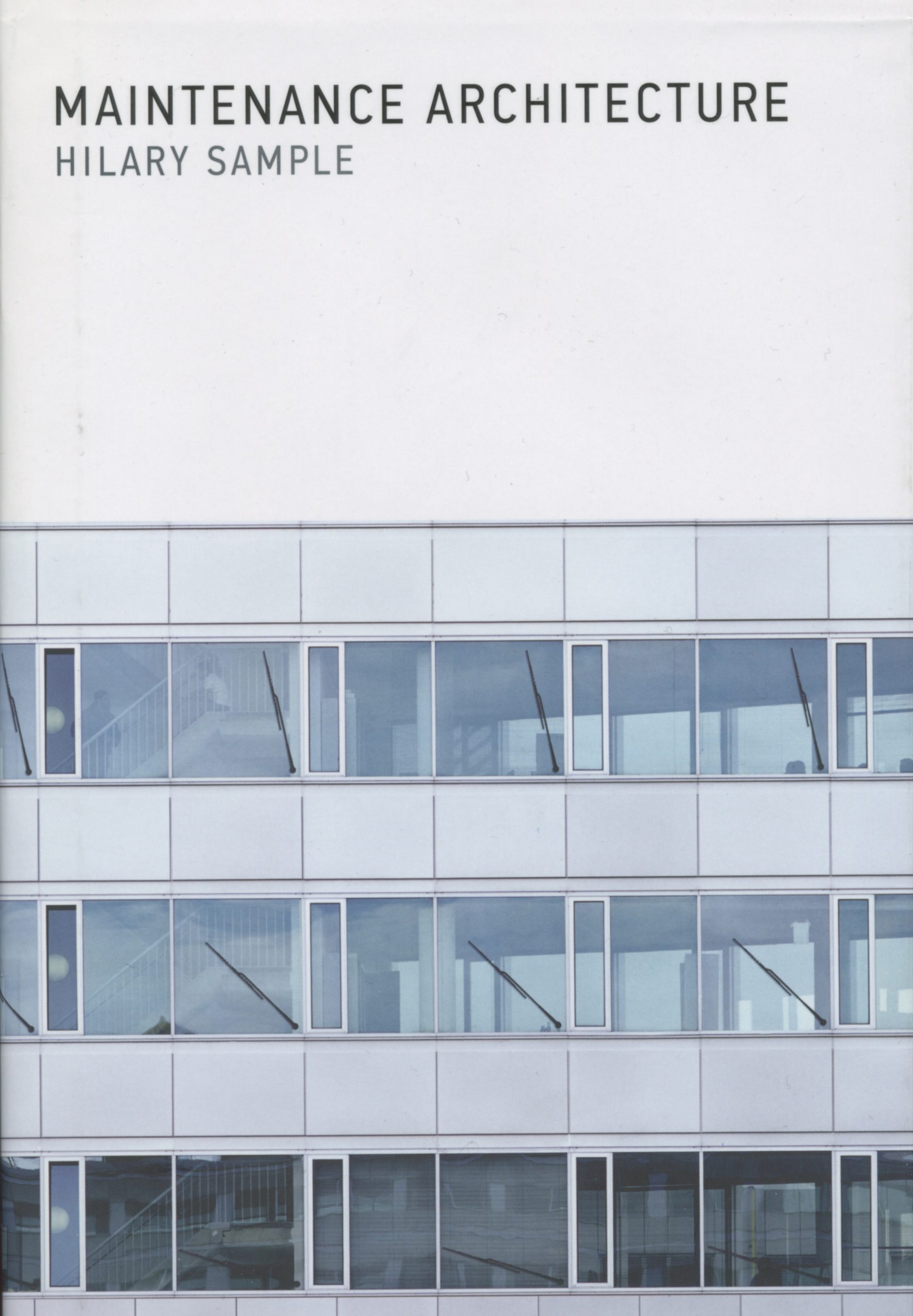Hilary Sample
MIT Press, 2016

In Maintenance Architecture, Hilary Sample skillfully addresses a subject—building maintenance—that has received little attention in architectural discourse. She argues that this “repression” results from the desire to present modern architecture as “perpetually new” in ideal buildings, and ideal images of ideal buildings (127). Instead, in a sequence of punchy, enjoyable vignettes that cover subjects such as the squeegee and the motorized window-washing gondola, Sample emphasizes the ever-presence of maintenance in the evolving lives of buildings. So often overlooked and ignored, maintenance workers are the stars of her book, whether they are visible, appearing as an urban spectacle on a building façade, or unseen, occupying a building within a building of cleaners’ cupboards and service spaces.
As the catalyst for her book, Sample cites artworks in which iconic modernist glass buildings are photographed while they are cleaned, including Jeff Wall’s Morning Cleaning, from 1999, depicting Ludwig Mies van der Rohe’s reconstructed Barcelona Pavilion. Distinguishing between cleaning as a private and personal activity and maintenance as a public and collective endeavor, Sample divides her book into five thematic sections. One section considers the politics of labor, a recurring and significant theme throughout the book. Other sections address image, decay, technology, and futurity.
Maintenance Architecture offers a critique of architectural practice but not of artistic practice. Sample questions architects for devaluing maintenance but does not ask why so many of the artists she praises have made maintenance and cleaning the subject of their art. The answer may be not only because artists wish to conflate art and life, but also because of the spectacle that cleaning offers when observed or displayed in a gallery setting. Conceiving maintenance as a means to reflect on the intersections between architecture, art, and life, and emphasize the increasing importance of environmental performance, Sample proposes a significant realignment of architectural practice in which building maintenance is both a central concern of design and the architect’s responsibility once a building is occupied, provocatively asking, “how would design practice and buildings change?”(157).
Sample does not mention another exhibition display of the same year, Patio and Pavilion, which helps to explain House of the Future and the Smithsons’ concerns at the time.4 Emphasizing the continuing relevance of the “make-do-and-mend” philosophy that had prevailed during rationing in the United Kingdom, which only ended in 1954, the pavilion was a shed of reused timber boarding with a corrugated plastic roof adorned with decayed and discarded objects that countered conventional norms of maintenance. Responding to intellectual, emotional, and physical needs in a simple and direct manner that was reminiscent of the primitive hut and appropriate to British postwar austerity, Patio and Pavilion was astutely described as “a frugal pastoral” by Lawrence Alloway, while Reyner Banham criticized it as “submissive to traditional values” and also remarked that it appeared to be “excavated after the atomic holocaust.”5
Sample’s selective analysis of the Smithsons thus reveals a paradox of her book. Although she criticizes the repression of maintenance in modern architecture and recognizes that buildings cannot resist change and “appear eternally new,” she nevertheless favors maintenance as a means to ensure that architecture appears modern and new (4). With a celebration of technology that is equally modernist, Sample appreciates sleek architecture and desires a comparable, smoothly functioning maintenance regimen.
Sample assumes that “maintenance is really the thing that brings us close and keeps us close” to “continual newness” (4). But, as she also recognizes, maintenance actually brings us close to decay, to the old as well as the new. The section entitled “Visualizing Decay” asserts that artists rather than architects “have brought issues of decay, damage, degradation and disappearance to the fore” (95). However, the images in the book affirm her preference in that many depict maintenance but very few depict decay. Emphasizing that “the purpose of maintenance” is to ensure architecture’s “enduring presence in time,” Sample associates decay with failure, as do many architects (23, 111–12). But what if decay is conceived as necessary to life? Sample praises the 2015 “Conservation Plan” for Louis Kahn’s Yale Center for British Art, New Haven, 1974, as “the first of its kind in the United States, as it calls for some parts of the building to be preserved and maintained while other elements will be more freely changed” (167). Indebted to John Ruskin, conservation policy assumes that each layer of a structure’s history should be retained because “we cannot remember without [architecture].”6 Sample’s concern for the politics of human labor and appreciation of architectural ingenuity beyond that of the architect recalls Ruskin, who concludes, “the greatest glory of a building is not in its stones, or its gold. Its glory is in its Age . . . it is in that golden stain of time, that we are to look for the real light, and colour, and preciousness of architecture.”7
- Alison Smithson and Peter Smithson, The Heroic Period of Modern Architecture (London: Thames & Hudson, 1981), 5.
- Ibid., 5.
- Alison Smithson, “Patio and Pavilion, 1956, Reconstructed U.S.A. 1990,” Places: A Quarterly Journal of Environmental Design 7, no. 3 (1991): 10–11.
- Nigel Henderson, R. S. Jenkins, Eduardo Paolozzi, and the Smithsons created this display for for This is Tomorrow, an exhibition curated by Theo Crosby at the Whitechapel Gallery, London.
- Lawrence Alloway, quoted in Lucy Lippard, Pop Art (London: Thames & Hudson, 1966), 36; Reyner Banham, “This is Tomorrow,” Architectural Review 120, no. 716 (September 1956): 187; and Reyner Banham, The New Brutalism: Ethic or Aesthetic (London: Architectural Press, 1966), 65.
- John Ruskin, The Seven Lamps of Architecture (1849; New York: Farrar, Strauss and Giroux, 1981), 169.
- Ibid., 169, 177.
How to Cite this Article: Hill, Jonathan. Review of Maintenance Architecture, by Hilary Sample. JAE Online. January 31, 2018. https://jaeonline.org/issue-article/maintenance-architecture/.






